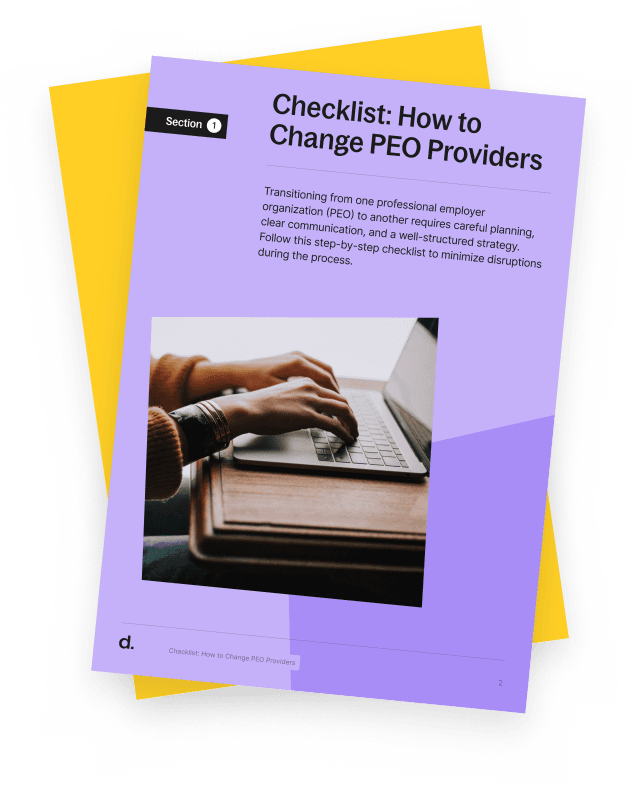Article
8 min read
ASO vs. PEO: Which is Right for Your Business?
PEO
US payroll

Author
Dr Kristine Lennie
Last Update
August 26, 2025

Table of Contents
What is an Administrative Services Organization (ASO)?
What is a Professional Employer Organization (PEO)?
What is the cost difference between an ASO and a PEO?
Key differences between ASO and PEO
When to choose ASO vs PEO?
Your checklist for choosing the right HR outsourcing service
Transform your HR and compliance management with Deel PEO
Key takeaways
- Businesses often partner with ASOs and PEOs to help them manage their HR, payroll, tax, and compliance burdens.
- ASOs suit businesses that require limited support and prefer to retain full legal responsibility and control over their workforce. Meanwhile, small and mid-sized businesses—or businesses entering the US market—benefit from PEOs’ more comprehensive services and shared liability model.
- Deel PEO empowers growing companies to channel their resources toward their strategic goals, by taking on the administrative load and compliance risks.
Businesses face a variety of challenges when it comes to balancing their HR and admin needs against individual growth strategies, resource constraints, and evolving compliance obligations.
For example, businesses with established People Ops might be looking for assistance with specific functions (such as payroll and benefits admin). Meanwhile, organizations with smaller teams could be seeking to offload most of their regulatory and back-office tasks—or, instead, be expecting a custom approach catered to their unique pain points. International companies entering the US market also often require wide-ranging HR, admin, and compliance support, especially while getting their new entities off the ground.
Administrative Services Organization (ASO) and Professional Employer Organization (PEO) are two types of HR outsourcing models that are commonly leveraged by companies to deal with these pressures. While both services aim to reduce the in-house burden of people management, they are fundamentally different in nature, yet often confused. Understanding the difference between the two is essential for making the right decision for your organization.
This guide will help you decide which model fits your business goals and long-term strategy.
What is an Administrative Services Organization (ASO)?
ASOs allow businesses to reduce their administrative load by taking on certain HR tasks, such as payroll, tax, and compliance processes. Benefits admin is also provided as part of the offering, but this does not include providing the client with access to more comprehensive plans.
In this setup, the client retains their employer status and has full control over employee management, but also bears all legal liabilities. When handling taxes and compulsory insurances such as unemployment insurance, ASOs do so under the client’s EIN (Employer Identification Number).
What is a Professional Employer Organization (PEO)?
Unlike ASOs, a PEO service operates under a co-employment agreement with the client. This means the PEO legally employs the workers on behalf of the client and assumes shared employment and compliance liabilities.
The client remains in charge of supervising and directing the employees’ day-to-day responsibilities, including working hours, goals, duties, and performance. The PEO handles the compliance aspects of employee hiring, termination, and promotion under the client's directive.
In short, the client remains the operational manager, while the PEO is the legal employer. Because of this, having a close relationship between the client and the PEO is essential for maintaining seamless workflows.
Similarly to an ASO, a PEO handles payroll, taxes, benefits, and compliance for the client—however, this is done under the PEO's own EIN, rather than the client's.
Because they pool employees from multiple businesses, PEOs also have access to large-group rates, better deals, and more options when it comes to negotiating benefit plans with providers. As such, PEOs can give clients (especially small and medium-sized businesses) access to more comprehensive packages compared to what they'd otherwise be able to get on their own.
Find out more with our short article on How Deel is Redefining the PEO Experience.
What is the cost difference between an ASO and a PEO?
ASOs and PEOs also differ in their pricing models. In general, ASOs' pricing can be lower, billing their clients in one of the following ways:
- A fixed rate per service provided
- A flat rate per employee
- A combination of the above
- A fee per on-demand service provided
In general, clients can lower prices for an ASO service. However, companies that use ASOs also need to pay separately for benefits plans and any compliance-related costs (fees, penalties, etc.).
By contrast, PEOs are typically paid:
- A percentage of payroll (usually, 2-12%)
- A flat rate per employee (with or without an additional admin fee)
The upfront cost of PEOs is typically higher, but it could lead to long-term savings as PEOs manage your compliance in full, mitigating any unexpected expenses associated with regulatory risks. Moreover, since PEOs enable access to large-group benefits packages, this can ultimately result in cheaper benefits premiums and reduce turnover and related costs.
Deel prices PEO services per employee per month. See Deel PEO's pricing page.
Key differences between ASO and PEO
From employer responsibilities and compliance risks, to benefits and costs, knowing how ASO and PEO services differ will help you determine the best solution for your team. Here is a look at the key differences:
| ASO | PEO | |
|---|---|---|
| Employer status | The client is the only legal employer and handles all associated responsibilities (onboarding, benefits enrollment, etc.) | PEO becomes a co-employer and shares the associated responsibilities |
| Compliance risk | The client is fully liable for legal compliance and any employment-related issues | PEO shares legal risk and helps ensure compliance with employment laws |
| Payroll and taxes | Client files taxes under their own EIN and handles compliance on their own | PEO files taxes under its EIN and manages most payroll compliance tasks |
| HR control | The client keeps full control over HR policies and decisions | The client gives up some control and works closely with the PEO on HR decisions |
| Benefits access | The client buys benefits independently. ASO may help with admin but not with plan access | PEO gives access to group benefits at lower rates, including health, dental, vision, and retirement |
| Costs | Lower cost if no need for benefits assistance but potential long-term added expenses from legal liabilities, admin, and fees | Higher upfront costs but potential long-term savings from reduced risk and better benefits |

When to choose ASO vs PEO?
The choice between an ASO and a PEO depends primarily on your business needs and priorities.
When to choose ASO?
In general, ASOs are an advantageous solution for businesses that are looking for help with core HR and admin functions while retaining legal responsibility and control over the workforce. Here are some of the reasons why you might choose an ASO:
- You already have a well-established HR team that requires some support, but not full outsourcing
- Your business is small and has limited needs that do not warrant an all-encompassing suite of services
- You prefer to maintain full legal control over your workforce and workforce-related processes and do not want to enter into a co-employment arrangement
- You want to manage your tax and reporting operations through your own EIN
- You already have existing benefit packages that only require some administrative support
- You prefer an option with a lower upfront cost
Overall, ASOs are a less comprehensive but more flexible and cost-effective solution for already well-structured businesses that need limited support with their HR functions.
When to choose PEO?
A PEO model that incorporates more comprehensive services and mitigates compliance risks can be especially valuable for international companies entering the US market, as well as small and mid-sized domestic businesses. Some of the reasons why a PEO might be a better fit for you include the following:
- You do not have the resources to maintain a large and comprehensive HR team
- You prefer to offload employment and compliance liabilities and focus all capabilities on growth
- You are interested in obtaining more attractive benefits packages that would you to be more competitive in the talent market
- You are expanding domestically into a new and unfamiliar market, with a limited workforce and experience navigating local employment regulations
- Your international business is entering the US market with a limited workforce and experience navigating US employment regulations
A PEO's co-employment model allows international and smaller businesses to reduce risk and outsource processes that aren't directly related to growth and innovation. This can help those organizations focus on scaling their operations without being held back by complex compliance and administrative tasks.
Your checklist for choosing the right HR outsourcing service
When choosing between a PEO or ASO, making an informed decision can significantly impact your efficiency and bottom line. The checklist below walks you through core considerations and questions to ask when assessing your options, and the service that, in each of the cases, best aligns with your business needs.
| Task | Question | Answers | Leans towards |
|---|---|---|---|
| Assess your business size, HR needs, and capacity | What is your business’ size? | Small Medium Large |
PEO PEO ASO |
| Do you expect workforce growth in the foreseeable future? | Growing workforce Stable workforce |
PEO ASO |
|
| Does your HR team have capacity for current and future needs? | Limited capacity Fully capable |
PEO ASO |
|
| Which HR services do you struggle with most? | Comprehensive HR, payroll, tax, compliance, benefits admin Admin support with payroll, tax, compliance benefits admin, and HR tools/documentation |
PEO ASO |
|
| Examine your compliance risks and tolerance | Do you plan to handle compliance risks internally or offload them? | Prefer offloading Handle internally |
PEO ASO |
| Do you have in-house compliance expertise? | Limited in-house expertise Strong in-house team |
PEO ASO |
|
| Is your workforce spread across multiple jurisdictions needing specific compliance? | Yes No |
PEO ASO |
|
| Are you hiring or expanding in new locations? | Yes No |
PEO ASO |
|
| Determine if you want to maintain full employer control | Do you want full control over hiring, onboarding, and employee admin, or outsource? | Comfortable outsourcing Prefer full control |
PEO ASO |
| Evaluate your benefits offering | How much support do you need for benefits admin? | High support needed Minimal support needed |
PEO ASO |
| Does your current benefits offering meet your talent acquisition and retention needs? | No, needs upgrade Yes, meets needs |
PEO ASO |
|
| Assess your budget | How are you budgeting for ongoing HR and compliance costs? | Willing to invest into a broader service Prefer lower, predictable costs |
PEO ASO |
| Are you expecting extra expenses from expansion or regulatory changes? | Yes No |
PEO ASO |
|
| Are you focusing on short-term or long-term cost efficiency? | Long-term Short-term |
PEO ASO |
|
| Research providers and pricing | How will services be billed? Are there cancellation fees? | Transparent, flexible billing Complex or unclear billing |
Either Neither |
| What level of support is included in service bundles? | Comprehensive Basic |
PEO ASO |
|
| Do providers require integration with your systems? | Yes No |
PEO ASO |
|
| Verify providers | Are verified client references or case studies available? | Yes No |
Either Neither |
| Do providers have credentials and a compliance history? | Yes No |
Either Neither |
|
| Have you requested demos to assess platform capabilities? | Yes No |
Either Neither |
Transform your HR and compliance management with Deel PEO
Businesses face different obstacles and constraints when it comes to managing HR, tax, and compliance operations. Making an informed decision about how best to navigate these challenges is essential for optimizing resources and ensuring long-term growth.
ASOs and PEOs are two effective solutions that businesses can take advantage of if they are looking to outsource their administrative and regulatory obligations. In general, ASO models are better suited for companies that require some support but prefer to retain full employee control and responsibilities.
On the other hand, PEOs provide small and mid-sized businesses, or international companies entering into the US, with a more comprehensive service offering, mitigate compliance risks for the client, and allow access to more competitive benefits packages.
Deel PEO is purpose-built to support businesses with distributed teams and complex compliance needs. Our expert team will help you streamline your operations, manage your risk, and save you valuable long-term resources, with no hidden costs.
Book a demo to speak with an expert about Deel PEO.
Deel PEO
Disclaimer: This article is not a substitute for legal advice. Please check official websites or seek legal advice before taking action.
FAQs
What is the difference between a PEO and an ASO?
Both PEO and ASO are HR outsourcing models, but while ASOs only provide certain administrative support to businesses, PEOs take on a role as a co-employer, absorb liabilities, and provide more comprehensive payroll, benefits, and compliance services.
Who should use a PEO?
PEO is an advantageous model for businesses with established entities who are looking to offload their HR, payroll, and compliance needs, while also gaining access to more competitive benefits packages for their employees. This includes international businesses entering the US market, as well as small and mid-sized businesses.
What is the difference between outsourcing and PEO?
Outsourcing typically involves hiring an external provider to manage certain tasks and functions. With a PEO, the client and the PEO sign a co-employment contract to share employer responsibilities. The client still handles the employee's day-to-day supervision and operations, while the PEO manages HR tasks, payroll, benefits admin, tax, and compliance.
Can government contractors use a PEO?
Yes, government contractors can use a PEO, provided the PEO contract and services are in alignment with all necessary government regulations (such as security clearances, reporting requirements, etc).

Dr Kristine Lennie holds a PhD in Mathematical Biology and loves learning, research and content creation. She had written academic, creative and industry-related content and enjoys exploring new topics and ideas. She is passionate about helping create a truly global workforce, where employers and employees are not limited by borders to achieve success.











